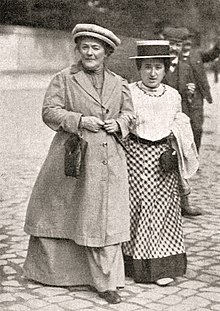共產主義婦女國際
共產主義婦女國際(英語:Communist Women's International)是共產國際下屬的國際婦女運動組織,活躍於1920年代。

歷史
編輯第二國際開展了婦女運動30年,[1]但直至第一次世界大戰女性參政權仍然難以獲得。[2]
1920年7月30日至8月2日伴隨共產國際二大召開了國際共產主義女性大會。[3]1920年初,她為共產國際二大起草了《關於共產主義婦女運酬的提綱草案》,同年11月又根據二大精神起草了《共產主義婦女運動的方針》。在這兩個文件中,她重申婦女的解放是工人階級歷史使命的重要組成部分,要吸收勞動婦女參加革命的階級鬥爭。1920年11月20日共產國際婦女書記處成立,蔡特金當選為書記。
1921年6月蔡特金在共產國際第三次代表大會上作了《關於共產主義婦女運動問題的報告》。她指出:"如果沒有婦女參加,無產階級就不能將自己的經濟鬥爭和政治鬥爭進行到底。"大會根據這個報告通過了《加強婦女工作的國際聯繫以及共產國際婦女書記處在這方面的任務》、《對婦女進行共產主義工作的方式和方法》兩個決議。
1922年初,從莫斯科遷往柏林。[4]機關刊物為 Die Kommunistische Fraueninternationale.[2]從1921年到1925年共出刊25期,[5] 約1300頁。[6]
當伊涅薩·阿爾曼德準備為女工寫一本小冊子,在提綱上列出婦女「要求戀愛自由」時,列寧在給她的信中要求刪除,因為他認為在資本主義條件下,「戀愛自由」不能確切表達無產階級的愛情觀:「問題不在於您主觀上『想』把這種要求『理解』成什麼,問題在於愛情上的階級關係的客觀邏輯。」[7]同樣,當列寧聽說蔡特金在婦女討論會上談到性和婚姻問題時,對蔡特金進行了嚴厲的批評。[8]
1924年共產國際第五次代表大會上,通過了《共產黨在勞動婦女中的工作》的決議,強調「必須大力展開在農村勞動婦女特別是農業國的農村婦女中間的工作」,並規定了爭取農村勞動婦女的任務以及工作方法。中國共產黨於1924年上半年設立了中國共產黨婦女部。
1925年5月15日改組為共產國際執委會婦女部,遷往莫斯科。[9][10]
1926年春,在莫斯科召開了第四次婦女工作國際會議。[11]
1939年婦女占蘇聯職工總數的40%。30年代末,美國共產黨中的女黨員占黨員總數的30%-40%;到1943年,美國共產黨8.3萬名黨員中有46%是婦女。美國共產黨創辦了一份名為《工作婦女》(Working Women)的婦女雜誌,後改名為《今日婦女》(Women Today),每月發行量達到8000份。
國際婦女大會
編輯| 大會 | 位置 | 日期 | Comments |
|---|---|---|---|
| 第一次共產主義婦女國際大會 | 莫斯科 | 1920年7月30日-8月2日 | |
| 第二次共產主義婦女國際大會 | 莫斯科 | 1921年6月 | |
| 國際女記者會議 | 柏林 | 1922年1月 | |
| 第三次共產主義婦女國際大會 | 莫斯科 | 1924年 | |
| 第四次共產主義婦女工作國際大會 | 莫斯科 | 1926年5月29日-6月10日 | |
| 十月革命十周年紀念婦女大會 | 莫斯科 | 1927年11月 | |
| 共產黨婦女部負責人會議 | 莫斯科 | 1930年8月 |
參考文獻
編輯- ^ E.H. Carr, A History of Soviet Communism (Volume 8): Socialism in One Country, 1924-1926: Volume 3—Part 2. London: Macmillan, 1964; pg. 976.
- ^ 2.0 2.1 John Riddell (ed.), Toward the United Front: Proceedings of the Fourth Congress of the Communist International, 1922. Leiden, Netherlands: Brill, 2012, pp. 589-590 (fn. 20).
- ^ Jean-Jacques Marie, "The Women's Section of the Comintern, from Lenin to Stalin," in Christine Fauré (ed.), Political and Historical Encyclopedia of Women. New York: Routledge, 2003; pg. 278.
- ^ Hertha Strum in Riddell (ed.), Toward the United Front, pg. 854.
- ^ Liberty Peterson Sproat, How Soviet Russia Liberated Women: The Soviet Model in Clara Zetkin's Periodical 'Die Kommunistische Fraueninternationale'. (頁面存檔備份,存於網際網路檔案館) Masters thesis. Brigham Young University, August 2008; pg. 31.
- ^ John Riddell, "The Communist Women's Movement, 1921-1926," International Socialist Review, whole no. 87 (Jan.-Feb. 2013), pg. 36.
- ^ 中共中央馬克思、恩格斯、列寧、斯大林著作編譯局編譯:「致伊•費•阿爾曼德」《列寧全集》第47卷第70頁 人民出版社,1990.
- ^ 蔡特金著,馬清槐譯.《列寧印象記》第61-66頁。北京三聯書店,1979年版.
- ^ "Work of the International Communist Women's Secretariat" in Riddell (ed.), Toward the United Front, pg. 871-872.
- ^ Marie, "The Women's Section of the Comintern, from Lenin to Stalin," pg. 281.
- ^ E.H. Carr, A History of Soviet Russia (Volume 12): Foundations of a Planned Economy, 1926-1929: Volume 3—Part 1. London: Macmillan, 1976; pg. 290.
延伸閱讀
編輯- Jean-Jacques Marie, "The Women's Section of the Comintern, from Lenin to Stalin," in Christine Fauré (ed.), Political and Historical Encyclopedia of Women. New York: Routledge, 2003; pp. 275–285.
- Liberty Peterson Sproat, How Soviet Russia Liberated Women: The Soviet Model in Clara Zetkin's Periodical 'Die Kommunistische Fraueninternationale'.(頁面存檔備份,存於網際網路檔案館) Masters thesis. Brigham Young University, August 2008.
- Elizabeth Waters, "In the Shadow of the Comintern: The Communist Women's Movement, 1920-43", in Sonia Kruks, Rayna Rapp, and Marilyn B. Young (eds.), Promissory Notes: Women in the Transition to Socialism. New York: Monthly Review Press, 1989.